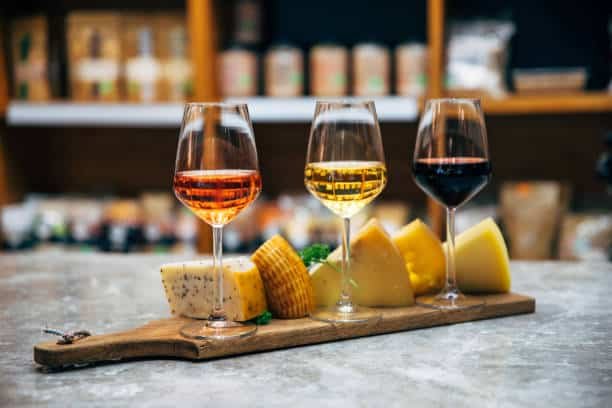Guide to Wine and Cheese Pairings.
Taste is a matter of personal preference, and there are no hard-and-fast laws on what beverages should be consumed with certain foods.
There are, on the other hand, some combinations of wine and cheese that, in terms of texture, fat, acidity, and salt, are exceptionally well-suited to one another.
Find out what makes those fan favorites so amazing, and learn how to design your own wine and cheese combos for a mouthful that tastes like a dream.
The Foundations of a Delicious Wine and Cheese Combination
The key to successfully pairing any dish with wine is to create harmony between the various tastes and textures of both the meal and the wine.
When it comes to combining cheese with wine, things aren’t much different.
The strength of the cheese, as well as its saltiness, fattiness, piquantness, acidity, tannins, and texture, all play a role in determining the kind of wine that is most suited to be consumed with it.
Platter with cheese and wine
Texture
The cheese’s consistency may change dramatically depending on the kind of milk used, the kind of cheese made, and the length of time it was matured for. Cheeses that are young, fresh, and rindless tend to be on the softer side.
When they are allowed to come to room temperature before being served, these cheeses may become mushy and almost completely disappear off the platter.
Hard cheeses, on the other hand, have a lot more of a bite to them and need to be crumbled or sliced before consumption. The younger, softer cheeses often match better with lighter wines like arneis, dry rosé, or light-bodied reds like zweigelt.
On the other hand, the heartier hard cheeses, like Parmigiano Reggiano, combine nicely with more substantial wines like Franciacorta, nebbiolo, or Bordeaux blends.
Intensity
When it comes to striking a balance, it is essential to ensure that the intensities are comparable.
The delicate flavor of white wine may be rapidly overpowered by a powerful blue cheese. In a similar vein, a bold red like Barolo may be too dominating for light ricotta.
Cheeses with a washed rind have their own unique stink and pungency, and they call for a wine that can hold its own. Imagine if each of them had their own distinct personalities; would they still want to be best friends? It’s best to pair introverts with other introverts and extroverts with other extroverts, in general.
Salt
Salt has an effect on how your palette recognizes other tastes, and certain cheeses have more salt than others.
Because salt enjoys the flavor of acid, a white wine from a chilly environment that has a racy acidity will be an excellent complement to a salty cheese such as halloumi. Consider wines such as Chablis, dry Riesling, or Muscadet.
Fat
It’s not true that all cheeses are created equal. There may be a significant difference in the amount of fat in cheese produced from cow’s milk, sheep’s milk, or goat’s milk due to the source of the milk used to make the cheese.
Acid also has a fondness for fat. Do you see a common thread? The fatty quality of a Camembert is cut through by a greener veltliner that is crisp, sharp, and acidic; this brings equilibrium to the gathering.
Age & Tannins
As cheeses mature, their tastes get more robust, complex, and concentrated, and they also become more flavorful. In this regard, they are comparable to older red wines, which, throughout the course of their maturation, acquire tertiary aromas and characteristics.
When you have a cheddar that has matured for 38 months, it will have developed a richness that calls for a wine with an equivalent degree of depth to pair with it.
The full-bodied tannins in a Chianti or nero d’avola will balance out the richness of the taste profile and bring everything together.
Think on a Local and a Regional Scale
Consider where you came from if you find yourself in a bind. The culinary culture of a particular location often has deep roots, and many timeless pairings originate from the traditions of the local cuisine.
For instance, a sauvignon blanc from the Loire region coupled with goat cheese made in the area and sourced from a farm just down the road would most likely be a successful pairing.
Mixing the Traditional with the Unexpected
When it comes to combining cheese with bubbles, white, red, rosé, or orange wine, there are no rules. There may be certain traditional combinations, but the possibilities are endless.
If you have a certain bottle in your wine cellar that you are wanting to break open for a little apéro and want a little more guidance, these traditional and unorthodox pairings are here to help you figure out what to serve with it.
A Guide to Matching Wine and Cheese
Garnacha & Manchego
Garnacha and Manchego are both native to Spain, and their flavors go well together. Garnacha’s luscious strawberry, purple plum, and savory character lend a brightness to the tongue, while the buttery, creamy, and aged Manchego adds a salty depth to the experience.
Gewürztraminer & Münster
Gewürztraminer is a magnificent grape that is brimming with the flowery scents of rose and ginger, in addition to lychee. The strong acidity and fragrant sweetness of this wine mix well with the similarly aromatic German Münster.
Sangiovese & Parmigiano-Reggiano
The well-known Italian grape contributes flavors of brilliant cherry, earthy tomato, and savory garden herb to the meal, while the aged Parmigiano-Reggiano cheese offers a rich, subtle nuttiness with spicy tyrosine amino acids to the table. A marriage made in paradise.
Moscato d’Asti & Gorgonzola
Gorgonzola is a cheese that has a good amount of character. It manages to be velvety while still being rich, tangy, and sharp all at the same time. Moscato is the perfect complement to the earthy flavor of Gorgonzola, which yearns for a touch of harmony.
After tasting gorgon, one should follow up with a glass of Moscato since it is lightly sweet and has a healthy amount of acidity.
Chenin Blanc & Crème Fraîche
Chenin from a region with a cold temperature has a rippling acidity, with delicate aromas of yellow and green fruit, overtones of chamomile, and a minerality that grounds it all. It’s a match made in heaven when served with a herb-crusted log of chèvre. Both complement one another without competing to an excessive degree.
Pinot Noir Rosé & Havarti
A happy-go-lucky rosé to pair with a happy-go-lucky cheese. The smooth, creamy consistency of Havarti pairs well with the delicate, but crisp and fruity characteristics of a pinot rosé. The acidity and tannins in this dish provide the perfect balance to cut through the decadence of the cheese.
Vermentino & Pecorino
This is one of those pairings that focuses on a hyper-regional area. Both Vermentino and pecorino originated in the Italian island of Sardegna, which is rather small.
Both the grape vines and the scrubby shrub that the sheep eat on take on similar light, savory, citrus, and salty qualities as a result of being engulfed by the salty sea. Like goes with like.
Port & Stilton
Port and Stilton have long been considered a classic match. The port’s flavor has a character that is just as robust as the cheese’s pungent aroma. This salty cheese gets just the proper amount of intensity thanks to the sweet flavors, substantial body, and richness that come with port.
Blaufrankisch & Comté
A juicy blaufrankisch with a medium body is full of brambly fruit, with undertones of allspice and zings of black pepper. When combined with a few long, winding ribbons of buttery and spicy old Comté, this wine that has been given a mild chill is a delectable treat on a hot day, especially when served with a tiny chill.
Cabernet Franc with Camembert, please.
The brambly fruit, mixed with a crushed gravel mineral quality, and a touch of chili pepper or bell pepper in a cab franc provide a lively and acidic pairing that works well with a thick and creamy camembert.
Champagne & Brie
Bubbles, bubbles, bubbles. Although they are adaptable to almost any cheese, they are particularly delicious when paired with a brie that is mild, buttery, and smooth. After tasting the richness of the Brie, one should follow it up with a glass of Champagne since it has a lively acidity and consistent, snappy bubbles.
Marsanne and Reblochon Contact Dermatitis
A marsanne with a lot of grip will include notes of quince, acacia, beeswax, and crushed apricots. This washed-rind soft cow’s cheese is a perfect complement to the somewhat edgy attitude that it exudes. The nuttiness of this orange wine is complemented by the cellar-like scents of Reblochon, which also have a creamy texture and a lasting quality.
Destined to Happen
Wine and cheese…almost it’s as if they were intended to go together, so regardless of which path you choose to follow on your quest to find the perfect combination, you’ll probably end up content.
When trying to make such matches, you should take into consideration not only the taste but also the texture and the geography. Make use of your intuition, and keep in mind that the most essential thing is that there are no rules.
Characteristics Of And Advice For Barolo Red Wine
8 Amazing Wine Health Benefits
Can Cabernet Sauvignon Be Refrigerated?






